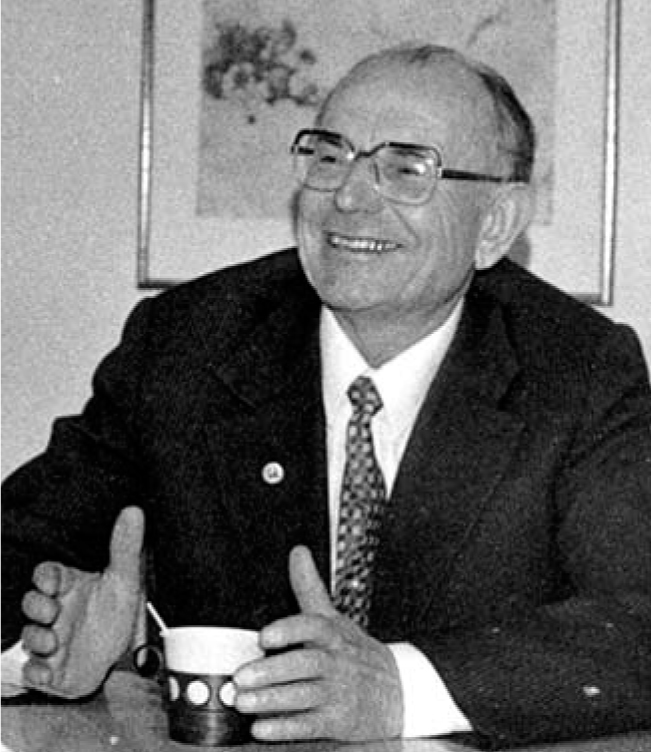Leonid Maksimovich Brekhovskikh
DOI: 10.1063/1.2155769
Leonid Maksimovich Brekhovskikh, the recognized leader in acoustics and physical oceanography research in Russia and the former Soviet Union, died of heart failure on 15 January 2005 in Moscow.
Leonid was born on 6 May 1917 into a peasant family in the village of Strunkino in the Archangelsk region of Russia, just south of the Arctic Circle on the shore of the White Sea. He received his university degree in physics from Perm State University in 1939 and was admitted to the Lebedev Physical Institute (FIAN) in Moscow for postgraduate work under the supervision of Igor E. Tamm, a future Nobel Prize winner. There he worked closely with Mikhail A. Leontovich and met fellow graduate student Alexander M. Prokhorov, another future Nobel laureate, who became Leonid’s best friend for life.
In 1941, after Leonid received his candidate of science (PhD) degree in physics for his dissertation on x-ray scattering in crystals, he joined FIAN’s acoustics laboratory, headed by Nikolay N. Andreev. There he first entered the field of underwater sound while working on the protection of ships from acoustically triggered mines. Later he developed a comprehensive theory of electromagnetic- and acoustic-wave propagation in layered media and was awarded a doctor of physics and mathematics degree from FIAN in 1947. He made fundamental contributions to the theory of diffraction by introducing the concept of diffraction rays and the tangent plane approximation, which describes wave scattering by a surface whose roughness is large compared to wavelength.
In 1946, trying to explain data from an acoustic propagation experiment in the Sea of Japan, Leonid discovered the deep sound channel in the ocean–a discovery that would have far-reaching implications for acoustic research worldwide and that eventually brought about a new discipline, acoustical oceanography. Due to competition between sound-speed increase with hydrostatic pressure and decrease with decreasing temperature, sound speed in the ocean typically has a minimum at a middle to upper depth. Like a particle in a quantum mechanical potential well, acoustic waves are trapped in the vicinity of a sound-speed minimum and are shielded from scattering at the rough boundaries of the ocean surface and bottom. Consequently, the waves can propagate for thousands of miles. This discovery by Leonid in the USSR was independent and almost simultaneous with that by Maurice Ewing and Lamar Worzel in the US.
Leonid left FIAN in 1953 to become the founding director of the Acoustical Institute in Moscow. He formulated the main research directions and supervised the staffing of the new institute, which still exists today. Leonid was among the first to recognize that acoustic methods can play a crucial role in understanding and quantifying physics of the ocean. He established the laboratory of acoustical methods of ocean research at the institute and undertook to design and build two dedicated acoustics and oceanographic research vessels, the Sergei Vavilov and Petr Lebedev. Under his supervision, those vessels together with four other Soviet research vessels participated in 1970 in the Polygon experiment, which first observed the mesoscale eddies that had been postulated by Henry Stommel in the mid-1960s and that challenged the concept of an ocean dominated by steady, large-scale circulation. Polygon was followed three years later by the Mid-Ocean Dynamics Experiments (MODE) under Stommel and the joint US/USSR POLIMODE experiments. Mesoscale phenomena are now known to account for more than 90% of the ocean’s kinetic energy.
Leonid remained director of the Acoustical Institute until 1961 and was a department head there until 1980. In 1980 he moved to the P. P. Shirshov Oceanography Institute, where he organized and led the ocean acoustics department until his death. Leonid was always surrounded by aspiring young scientists. Between 1953 and 1966 he was a professor and department chair at the Moscow State University; between 1975 and 1997 he chaired a department and taught at Moscow Institute of Physics and Technology. From 1969 to 1992 he was a member of the presidium of the USSR Academy of Sciences, where he supervised the academy’s research in oceanography, atmospheric physics, and geography, and fostered international cooperation between scientists.
For decades, Leonid’s research addressed key issues and shaped the agenda in environmental acoustics, nonlinear wave interaction in the ocean, and acoustic oceanography. Among the numerous books Leonid wrote, a special place belongs to Waves in Layered Media. First published in Moscow in 1956, the book was translated into English and Chinese and had five editions by 1980. It has since become a classic reference and textbook for several generations of researchers around the world. Many physicists who never met Leonid consider themselves his students, having learned wave propagation theory from his book.
Leonid received many honors and awards, including the Lenin Prize in 1970 and the Rayleigh Gold Medal of the UK Institute of Acoustics in 1977, and was elected to the USSR Academy of Sciences and the US National Academy of Sciences. Leonid used to say that he was fortunate to live the dream of his youth–to combine theoretical physics with traveling around the world. He enjoyed running, skiing, and practicing yoga. His firmness of purpose, vision, wisdom, uncompromising integrity, modesty, and kindness were a great example for all who knew him.


More about the Authors
Peter Mikhalevsky. 1 Science Applications International Corporation, Arlington, Virginia, US .
Oleg Godin. 2 University of Colorado, Boulder, US .
Konstantine Naugolnykh. 3 National Oceanic and Atmospheric Administration’s Earth Science Research Laboratory, Boulder, Colorado, US .
Nikolai Dubrovsky. 4 N. N. Andreyev Acoustics Institute, Moscow.




